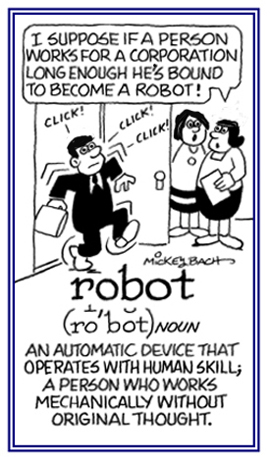There is no consensus regarding which machines qualify as robots; however, there is general agreement among certain people that robots tend to do some or all of the following: move around, operate a mechanical limb, sense and manipulate their environment, and exhibit intelligent behavior; especially, behavior which imitates humans or other animals.
In reality, modern industrial robots have very little physical or no resemblance to humans. It depends on which robot a person is referring to.
2. Etymology: from Czech robota, "work, forced labor, drudgery."
Go to this Word A Day Revisited Index
so you can see more of Mickey Bach's cartoons.
The design notes for the robot appear in Leonardo's sketchbooks that were rediscovered in the 1950's.
Since the discovery of the sketchbook, the robot has been built based on Leonardo's design; this proved it was fully functional, as Leonardo had planned.
The robot is a warrior, clad in German-Italian medieval armor, which is apparently able to make several human-like motions.
These motions include sitting up, moving its arms, neck, and an anatomically correct jaw. It is partly the result of Leonardo's anatomical research in the "Canon of Proportions" as described in the Vitruvian Man.
Mailbots are often used to send out-of-office replies, but can be made to send back any message.
Mobile robots can move around in their environment and are not attached to one physical location; in contrast, industrial robots usually have a jointed arm (multi-linked manipulator) and gripper assembly (or end effector) that is secured in a fixed surface.
2. An aircraft adapted to control by or through a preset self-reacting unit or a radio-controlled unit, without the benefit of a human pilot.
2. A small winged missile that is loaded with explosives, jet-propelled, and guided only by a gyroscopic robot device.
2. The process of creating a robot.
